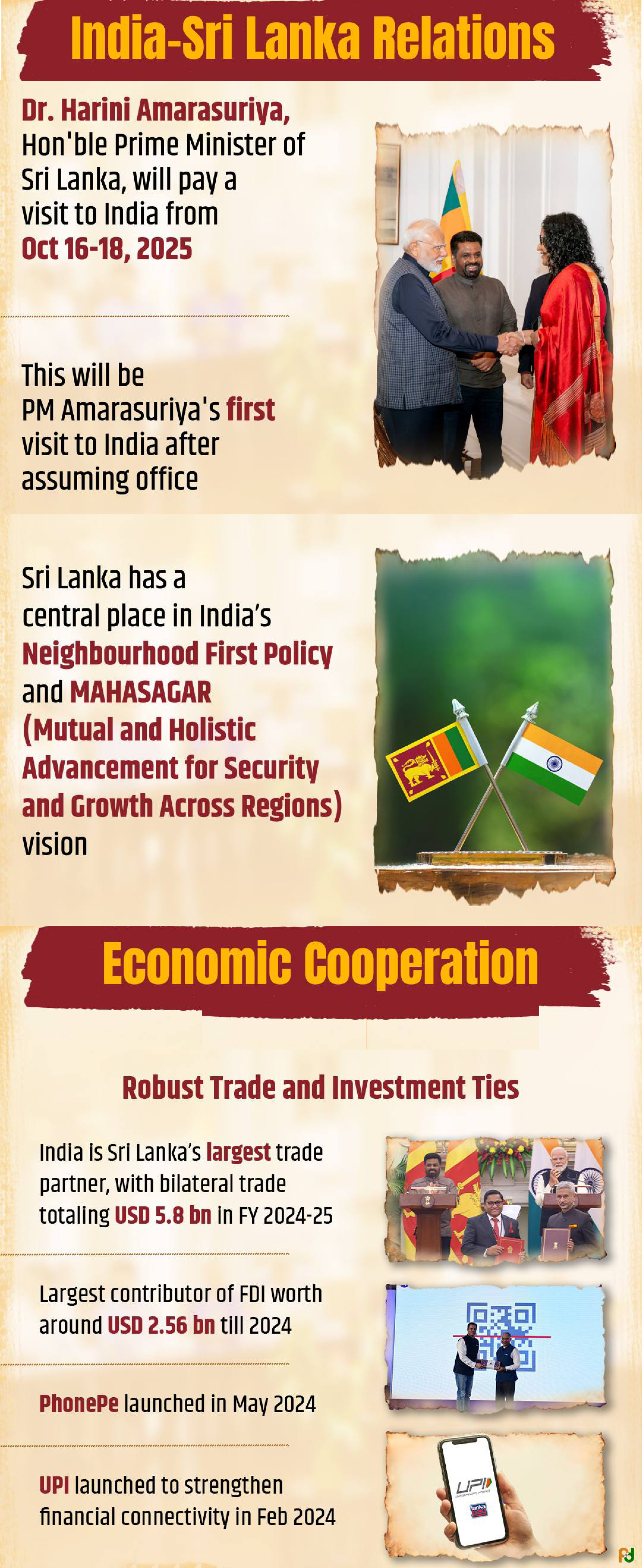Context:
Recently, Sri Lanka’s Prime Minister Harini Amarasuriya undertook her first official visit to India since assuming office.
Key highlights of the visit:
-
- Sri Lankan Prime Minister Dr. Harini Amarasuriya highlighted the need to upgrade the 1998 FTA to reflect contemporary realities. She observed that both economies have diversified significantly, and trade now extends beyond goods to include services, technology, digital commerce, and green industries.
- During the meeting with PM of India, discussion encompassed education, women’s empowerment, innovation, development cooperation, and technology, reflecting Sri Lanka’s interest in learning from India’s rapid socio-economic transformation. Both countries also explored opportunities in trade, investment, tourism, and digital governance, emphasizing a knowledge-based, people-centric approach to development.
- Several Agreements and MOUs were signed or discussed covering infrastructure, education & skilling, fisheries welfare, and development cooperation.
- Sri Lankan Prime Minister Dr. Harini Amarasuriya highlighted the need to upgrade the 1998 FTA to reflect contemporary realities. She observed that both economies have diversified significantly, and trade now extends beyond goods to include services, technology, digital commerce, and green industries.
Significance of the Visit:
-
- Neighbourhood First policy in action: For India, Sri Lanka is a key neighbour. This visit underscores Delhi’s intent to strengthening that relationship meaningfully.
- Balance amid regional competition: With Sri Lanka navigating relationships with multiple major powers, this visit helps India maintain a strategic edge and reassure the island nation of India’s partnership.
- Economic & security dimensions: Sri Lanka’s recovery from recent economic stress and its maritime location make enhanced connectivity, infrastructure and energy collaboration with India highly relevant.
- Neighbourhood First policy in action: For India, Sri Lanka is a key neighbour. This visit underscores Delhi’s intent to strengthening that relationship meaningfully.
Key Challenges:
-
- Fishermen & maritime concerns: One persistent area of tension has been the welfare of fishermen and maritime boundary issues. The two sides acknowledged the need for a cooperative approach.
- Ensuring implementation: As with many high-level visits, translating agreements into on-the-ground outcomes (infrastructure, investment, connectivity) will be the real test.
- External pressures and competing influences: Sri Lanka remains a region of interest to other powers as well; managing that while maintaining autonomy and the India link will continue to be delicate.
- Sustainability of momentum: With such visits there is a risk of high expectations without follow-through. Long-term relevance depends on steady implementation and follow-up mechanisms.
- Fishermen & maritime concerns: One persistent area of tension has been the welfare of fishermen and maritime boundary issues. The two sides acknowledged the need for a cooperative approach.
Conclusion:
The visit of the Sri Lankan Prime Minister to India marks a forward-looking phase in bilateral relations — one that emphasises education, innovation and maritime security alongside economic ties. With strategic alignment in place, the real test will be anchored in sustained implementation and addressing the underlying frictions with tact and mutual trust.







